- The Philippine Export Development Plan (PEDP) 2018-2022’s export targets are undergoing a periodic review
- Proposed revisions to align with effects of pandemic and impact to economy
- Government optimistic of still reaching the lower-end export target of $122 billion by 2022
The government is reviewing the Philippine Export Development Plan (PEDP) 2018-2022 to assess if export targets are still doable in view of the economic impact of the coronavirus (COVID-19) pandemic.
“Currently, we are reviewing and assessing the PEDP’s strategies indicators and export targets to see if such are still doable or not and continue to be optimistic that we will be able to still achieve even the low-end target of $122 billion in 2022,” Trade undersecretary Abdulgani Macatoman said in his opening remarks during the recent National Export Congress.
PEDP 2018-2022 has set an export target of $122 billion to $133 billion by 2022.
In a separate address, Trade Secretary Ramon Lopez said the PEDP is undergoing its periodic review and the agency has “proposed revisions aligned with the pandemic effects and impact to our economy.”
Lopez noted that the pandemic “rocked the whole world with a health crisis like no other—creating havoc in the world’s economy and changing the way how we work, how we operate a business, and how we deal with our daily lives into a new world order or what is now popularly known as the ‘new normal.’”
He noted several projects which can be considered for the PEDP, specifically the upskilling and reskilling of the workforce.
Lopez also noted the pandemic has also “facilitated and forced both government and private sector to pursue their programs of innovation and digitalization” and has brought businesses, particularly the exporting community, to go digital “to survive and beat the current crisis for a better future.”
“For businesses including exports to thrive in this technological era, there is need to adapt 4IR (Fourth Industrial Revolution) solutions to help propel and boost exports through an improved business regulatory framework and climate such as ease of doing business, better infrastructure and logistics, etc.,” Lopez said
“For technology and innovation, there is need to seek for new business models that can boost the creative acumen of businesses specifically in the export sector. Technological advancement is today’s norm and the export sector needs to really be in synch with all these developments” he added.
Lopez added that the export community will play a very critical role in the country’s implementation of 4IR, and will need the assistance of government agencies to effectively boost the country’s export performance “especially in these trying times.”
The DTI chief has called on government to take the lead in digital transformation by speeding up electronic-governance projects; hastening the rollout of mobile network infrastructure through a common tower policy; and fostering policies that reduce the digital divide and create a business environment conducive to the digital economy.
Macatoman, meanwhile, urged the export sector to help the government craft policy reforms “that will not only improve and boost the performance of our export but [will] generate the much needed revenues for the economy and jobs for our people.”
“Let us, together, leverage and make use of available and cutting edge digital tools and continue to innovate as entrepreneurs so that we remain competitive in this evolving digital economy,” he added.
The Development Budget Coordination Committee, in its latest macroeconomic assumptions, forecast that goods exports will contract by 16% this year but should expand 5% by 2021 and 2022.





